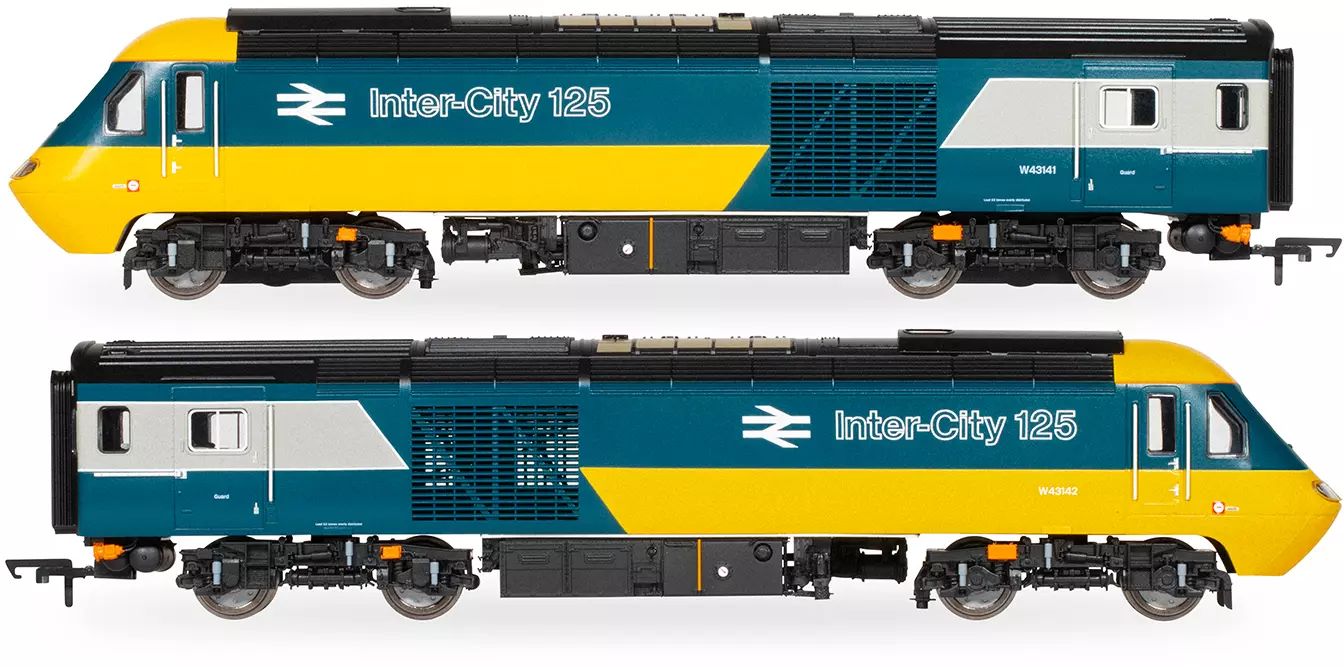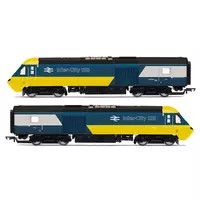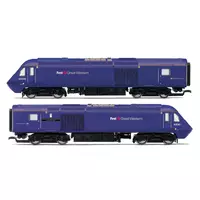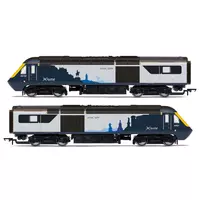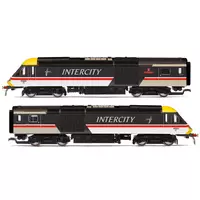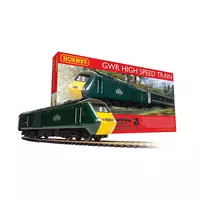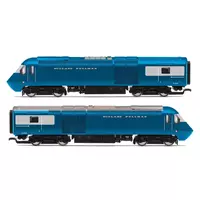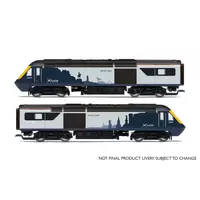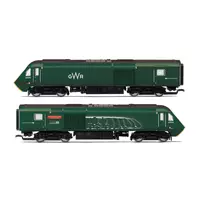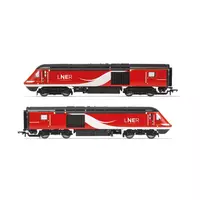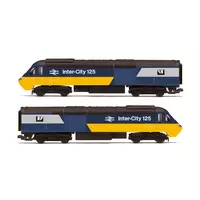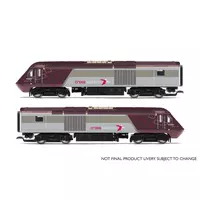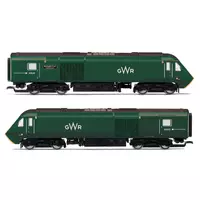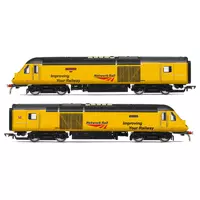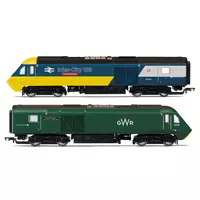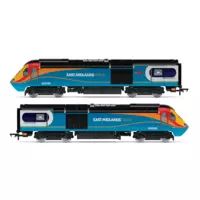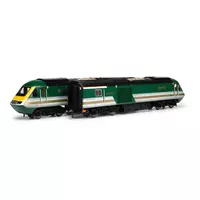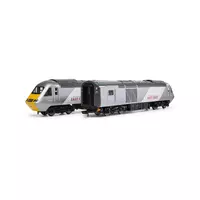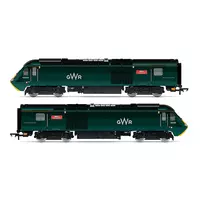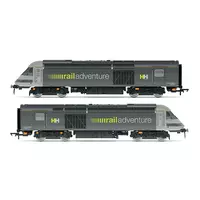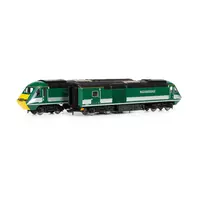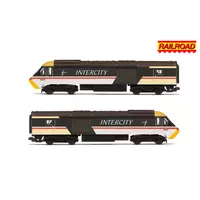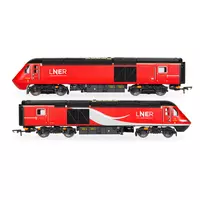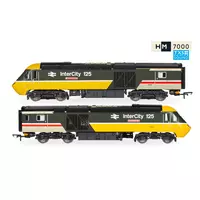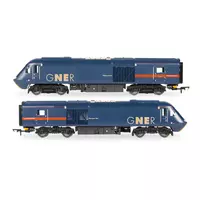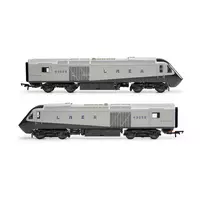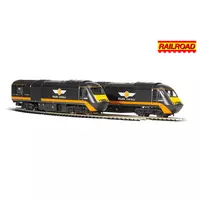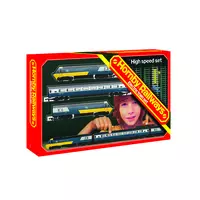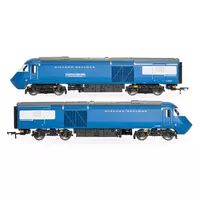Manufacturer catalogue image - please note that pre-release images may be CAD renders or CGI images rather than photographs
Prototype Era
Era 7 (1972 to 1982) British Rail Blue (TOPS)
Manufacturer description
Originally conceived as a cheaper, more reliable alternative to the Advanced Passenger Train in the early 1970s, the British Railways Board authorised the development of a prototype High Speed Diesel Train, with two locomotives designated as Class 41. These aerodynamic power cars were constructed by British Railways Engineering Ltd at their Crewe Works and emerged in June and August 1972, fitted with Paxman Valenta 12RP200L engines, developing 2,250 hp.
The power cars, having initially been numbered 41001 and 41002, were later given the coaching stock numbers 43000 and 43001 for operating trials on the Eastern Region and subsequent transfer to the Western Region. Following evaluation and a change of name to High Speed Train, British Rail placed orders for similar trains for use on the Western, Eastern, Scottish and London Midland Regions.
When originally built at BREL's Crewe Works, the InterCity 125 units were considered to be diesel multiple units and allocated as Class 253 to the Western Region and Class 254 for the Eastern Region. With the introduction of Trailer Guard Second (TGS) carriages, later power cars had no guard's equipment installed and by 1987 most power cars were simply classified as Driving Motor (DM), although they still had luggage van space, retaining a window by the luggage door on each side.
Following problems with the power cars and the operational ease of removing power cars to perform scheduled maintenance, unit formations were abandoned, resulting in the Class 43 locomotive prefix being adopted. The 197 Class 43 power cars produced between 1976 and 1982 were numbered 43002 to 43198 and are officially the fastest diesel units in the world. The units have an absolute maximum speed of 148mph (238kph), which is the current world diesel traction record, set on November 1, 1987.
In 1987, for trial purposes, eight of the Class 43s were converted for use as Driving Vehicles with the Class 89 and Class 91 locomotives. The power cars were fitted with buffers and Time Division Multiplex (TDM) equipment that allowed them to directly control the other locomotive.
Following the delivery of British Rail's Mk 4 coaching stock, the TDM equipment was removed and the power cars reverted to their normal duties, retaining their buffers. During the late 1990s, twenty-five of the Class 43s were updated with Paxman 12VP185L engines in an attempt to reduce fuel consumption and emissions; however these proved to be less reliable in service than was hoped.
No. 43141 was constructed at Crewe Works and entered service in April 1980 painted in a BR Blue and Grey ‘Inter-City 125’ livery. A W prefix was also added to the running number in its early days of service. As part of the HST set, 253036, this locomotive worked in the Western Region. The original Paxman-Valenta engine was replaced with an MTU 16V4000 R41 engine in August 2006 at Brush Traction. In December 2006, 43141 was outshopped and re-entered service under First Great Western, painted in a ‘Dynamic Lines’ livery.
From 2016 until 2018, the Class 43 locomotive carried a Welsh ‘Blwch Signalau Panel Caerdydd 1966-2016’ nameplate. It directly translates to Cardiff Panel Signal Box. This locomotive was sent to Scotland on 12th October 2018 and was assigned Edinburgh Haymarket as its depot. Its current operator is ScotRail and is painted in a ScotRail HST ‘Inter7City’ dark blue and pale grey livery with landmark decals.
No. 43142 was constructed at Crewe Works and entered service as part of the 253036 HST set. Like the locomotive, No. 43141, this car’s running number also had an incorporated W prefix and a BR Blue and Grey ‘Inter-City 125’ livery. The locomotive gained a ‘St. Mary’s Hospital Paddington’ nameplate in 1986 until it was removed in 1989.
In 2007, the locomotive was moved to Brush Traction to replace the Paxman-Valenta engine with an MTU engine. It re-entered service under First Great Western in a ‘Dynamic Lines’ livery. 2011 saw a ‘Reading Panel Signal Box 1965-2010’ nameplate be fitted to the locomotive. In 2019, this nameplate was removed due to the locomotive being moved to Scotland on 18th June 2018 to make way for a new operator. The current operator is ScotRail and is painted in a ScotRail HST ‘Inter7City’ dark blue and pale grey livery with landmark decals.
Upgraded for 2023, the Hornby Class 43 pack includes lights front and rear, kinomatic coupling system and motorised fans in the roof on certain HST's where the fan is visible through the roof vents. Fitted with a 5 pole motor and dual flywheels the motor car is all wheel drive. Both units are fitted with 21 pin DCC sockets and pre-fitted dual speakers which allow for the use of sound on DCC as well as offering greater control of the lights and fans.
Catalogue listing
Model details
Prototype information
* Class names often change over the lifespan of a locomotive, so this is not necessarily the class name used by the operator in the period modelled.
Supplier links are provided for your convenience and do not guarantee that the product is currently available. RailwayModels.uk is not a representative of these suppliers, but may receive a commission when purchases are made through links on this page.
